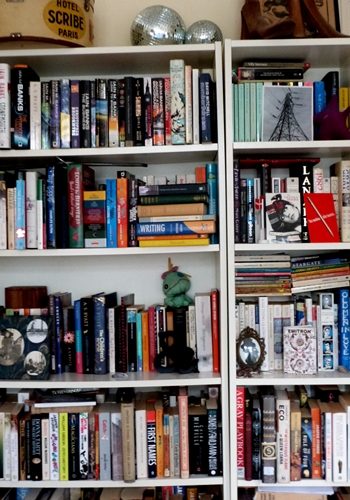Books & Wool, But Of Course
 I gave away about 80% of my books when I left Denmark and I can still see ghosts on the shelves, though I merged my collection with Dave's when we started living together. So many books.
I gave away about 80% of my books when I left Denmark and I can still see ghosts on the shelves, though I merged my collection with Dave's when we started living together. So many books.
Reading my 2006 blog posts I sounded so cavalier about culling my book collection:
"Red is for never again, never, no, it is so replaceable and it was fun but now the thrill has gone
Yellow is for what a lovely edition, I’ll never find it again and my library wouldn’t be complete without it.
Green is for of course, without a question, it’s part of me and good memories of dear ones.
I may not have a driver’s license but I have many books. I’m putting tiny stickers on their backs: red, yellow, green. So far at least 100 books have been marked with red: Borges*, Jonathan Safran Foer, Ian McEwan, DH Lawrence*, Jane Austen, Thomas Mann* and, er, Marion Zimmer Bradley. The yellow category is the difficult one. Which of Margaret Atwood’s works are yellow and not green? Should I put a bright yellow sticker on John Ruskin or is that a red (because I’m sure there’s a nicer edition out there)?
As I go through my books I realise I’m a flirty reader. I pick up books, break their hearts & spines and drop them cruelly. So many books I never finished: Anita Brookner, Iris Murdoch, James Kelman, Samuel Butler and John Barth. I’m so sorry but it’s not you, it’s me.
And the green books. My friends, my family. Alasdair Gray, Jonathan Coe, AS Byatt, John Donne, Vladimir Nabokov, Philip Pullman, Ezra Pound and EM Forster. I pet you gently and remember when I first encountered you. You are in my blood. You are going nowhere.
*victims of the bad edition rule"
And so we're back to 2014. Still so many books and they are not alphabetised. Fret.
Speaking of books, I am currently reading David W. Anthony's The Horse, the Wheel, and Language: How Bronze-Age Riders from the Eurasian Steppes Shaped the Modern World. It's an interesting look at the Proto-Indo-European language (the ur-language that spawned English, Greek, Hindi, Russian etc) and how PIE is reconstructed following linguistic rules. Anthony also looks at words and concepts that are found throughout the descendants of PIE. Words relating to wagons and wheels, certain types of animals and - relevant to my working life - textiles.
Anthony traces the possible origin* of the word wool - *HwlHn- as PIE contains roots for sheep, ewe, ram and lamb. He argues convincingly that these linguistic fragments point to a domestication of sheep. He also looks at archaeological evidence from Uruk that indicates sheep began being bred for their wool around 3350 BCE. The book then follows the linguistic fragments as they start to spread across the PIE areas. *HwlHn shatters into *Hwel- or *Hwol- .. but the word fragment doesn't always mean "wool". Sometimes it means "to felt", "something made of felt/wool", "to press" or "to weave". Anthony even looks briefly at whorls and spindles. Most of the book is devoted to horses and wheels (as the title indicates) but I did enjoy the dip into textiles. I'm now settling into a section on Neolithic farming in the Caucasus. As you do.
PS. Lots of people have posted pictures of their bookshelves (shelfies?). Do join in!